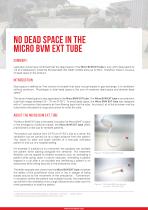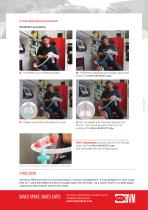
Catalog excerpts

NO DEAD SPACE IN THE MICRO BVM EXT TUBE Summary: Laboratory tests have confirmed that the dead space in the Micro BVM EXT tube is only 4.5ml (equivalent to 1/3 of a tablespoon), while the ISO standard-ISO 10651-4:2002 allow up to 65ml. Therefore, there is no issue of dead space in the product. Introduction: Dead space is defined as “the volume of a breath that does not participate in gas exchange. It is ventilation without perfusion. Physiologic or total dead space is the sum of anatomic dead space and alveolar dead space”1. The issue of dead space is also applicable to the Micro BVM EXT tube. The Micro BVM EXT tube is an extension tube that ranges between 23 – 75 cm (9-30”). To avoid dead space, the Micro BVM EXT tube was designed with a T connection that prevents air from flowing back into the tube. As a result, all of the air blown into the tube enters the patient’s lungs and cannot re-enter the tube. about the Micro BVM EXT Tube 2 The Micro BVM EXT tube is the latest innovation of Micro BVM . Unique in the emergency medicine market, the Micro BVM EXT tube offers practitioners a new way to ventilate patients. The product can expand from 23-75 cm (9-30”), and as a result, the ventilation can be carried out at a slight distance from the patient. This allows for safer and easier transfer of a manually ventilated patient in and out of a hospital setting. For example, if a patient is on a stretcher, the caregiver can ventilate the patient while walking alongside the stretcher. This treatment flexibility can be applied to endless scenarios such as ventilating a patient while going down a narrow staircase, ventilating a patient trapped in a car after a car accident and ventilating a patient in an ambulance while sitting securely in the ambulance chair. The latter example also shows how the Micro BVM EXT tube increases the safety of the practitioner since s/he is not in danger of being tossed around by the movement of the ambulance. Furthermore, in situations where the patient has multiple injuries, the practitioner can perform the ventilation from a slight distance and make room for other paramedics to treat the patient. 1 https:/ /www.openanesthesia.org/aba_respiratory_function_-_dead_space/ 2 https:/ /www.microbvm.com/products/micro-bvm-ext/ Figure 1: The Micro BVM EXT Tube Figure 2: The Micro BVM can expand from 23 - 75 c
Open the catalog to page 1
The Micro BVM EXT tube also secures the airway and reduces the risk of unwanted extubation. While unwanted extubation can occur in any setting, the risk is greater in the prehospital setting since the patient is transferred and moved more frequently. Studies have suggested that endotracheal tube (ETT) dislodgement occurs in 3.0% of patients3. The Micro BVM EXT tube addresses this important complication and once an ETT or LMA has been inserted and set, the Micro BVM EXT tube protects it from unwanted extubation. The EXT is very light weight and agile. As a result, it adjusts itself to the...
Open the catalog to page 2
FlowAnalyser Analysis Figure 7: Testing for dead space in the Micro BVM EXT tube Figure 9: 3D illustration of the T-Valve.
Open the catalog to page 3
2. How dead space is prevented: Ventilation procedure: B: The BVM is squeezed and oxygen (blue line) enters The Micro BVM EXT tube C: Oxygen penetrates the patient’s lungs. D: CO2 is exhaled (red line) and released into the air. The T valve prevents the CO2 from entering The Micro BVM EXT tube. The T connector prevents the air from flowing back into The Micro BVM EXT tube and eliminates the risk of dead space. Figure 10: The T valve connected to the PEEP and Viral filter Conclusion: The Micro BVM Ext tube is a novel accessory in airway management. It was designed in such a way that its T...
Open the catalog to page 4All Micro BVM catalogs and technical brochures
-
EXT Tube User Manual
6 Pages
-
Pocket BVM User Manual
64 Pages
-
Micro BVM brochure
4 Pages




